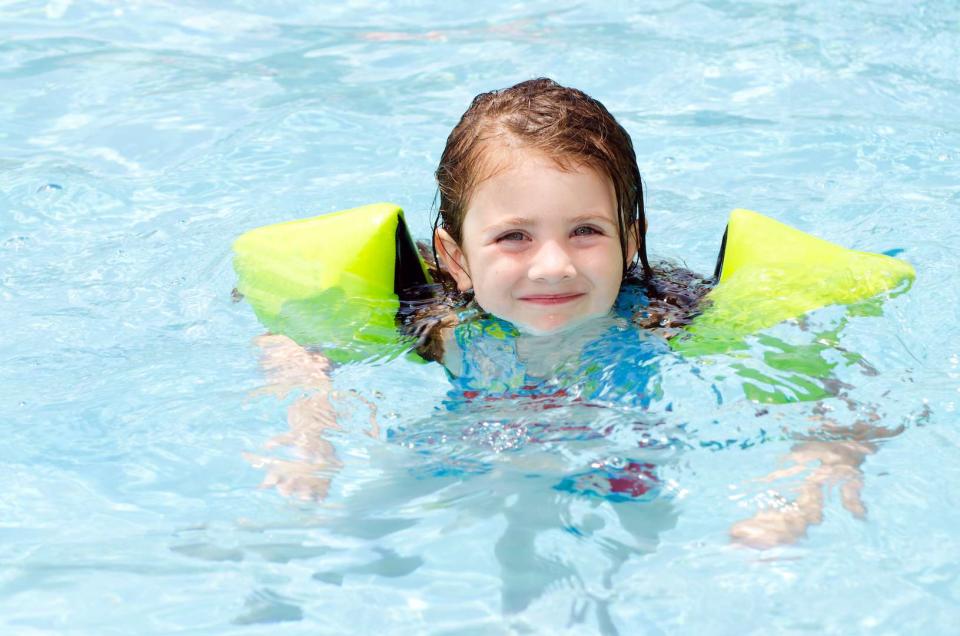Are Water Wings Safe for Toddlers and Babies?
Water wings help your little one stay afloat, but you can't rely on them to prevent drowning.

Swimming is a wonderful outing the whole family can enjoy, even babies and toddlers. Early exposure to the water often helps make learning to swim—and love the water—easier. But while much fun can be had, safety needs to be your number one priority when it comes to water activities with kids, especially if you're considering using water wings for little ones.
Water wings can help nonswimmers safely experience the water, but only with proper adult supervision. The biggest danger is that it may be tempting to put water wings on your child and let them explore the shallow end without watching them vigilantly.
But if your baby or toddler can't swim, using these floatation devices without being within arm's reach and keeping your eyes on them can put them at risk of drowning. Find out more about the safety concerns of using floaties, and learn the best ways to keep your child safe in the water if you do use water wings.
Related:An A to Z Guide to the Summer Season
The Safety Risks of Water Wings
There are a number of important considerations to evaluate before using water wings with your baby and toddler. The most crucial is to understand how they can actually create added risks of drowning or injury. That said, water wings can be a fun—and safe—way to enjoy the water with your child. However, caution must always be used to ensure the child's safety.
"Water wings are a tool for parents to let babies experience the water, but they are not safety devices," says Lauren Stack, former managing director of the regional division at the now-defunct National Swimming Pool Foundation.
Potential dangers include that the wings can easily come off your kid's arms, especially if they don't have an attached chest piece. (Choosing a product with a chest piece helps to mitigate this concern.) The inflatable material can also puncture, deflate, or loosen. Plus, if your child rolls onto their stomach, the water wings may prevent them from turning over again, making it harder for them to get a breath of air.
Related:How to Prevent Child Drowning
Additionally, Stack adds that water wings can give a false sense of security. Little kids might think they'll always float to the top of the pool, even if they aren't wearing the wings. This confidence might inspire them to jump into the water without any safety device, potentially leading to injury or accidental drowning.
Children aren't the only ones who become too dependent on the floaties, either. "If parents rely on water wings, you'll always think your kid will come right up," says Stack. Parents may mistakenly assume that it's safe to look or step away for a moment. For example, you may let yourself relax by the pool—scrolling through Instagram or sneaking in a few pages of your novel— and not realize your kid's water wing has come loose or they're lying face-down in the water.
Finally, water wings can prevent your child from learning proper swimming techniques that keep them afloat. The floaties put kids' bodies in a vertical position. In reality, though, bodies don't stay upright in the water. Learning to swim requires a comfort level with getting one's head wet and being horizontal in the water. Children accustomed to floaties must work extra hard to find the correct center of balance.
Related:Tips for Teaching Kids With Autism to Swim
Should My Kid Use Floaties?
You can still use water wings if desired, as long as your child is within arm's reach of an attentive adult at all times. "Ninety percent of all drownings happen within 30 feet of safety, and 60% happen within 10 feet of safety," says Stack. Parents within arm's reach can immediately sense if their child's water wings fail and come to the rescue. Plus, interacting with your child in the water is part of the fun!
Related:9 Home Swimming Pool Safety Tips
As a better solution, especially once a child is a few years old, Stack recommends enrolling them in professional swim lessons. "The best thing to do is teach your child how to swim," she says. "Formal swim lessons reduce the risk of drowning by 88%."
Until then, it's best to choose a personal floatation device that's approved by the U.S. Coast Guard, and don't let your child swim alone until they're completely capable. That said, remember that even kids (and adults) who are exceptional swimmers need to be monitored in a pool or other bodies of water, as drowning can happen to adept swimmers, too.
Related:The Best Swim Diapers

